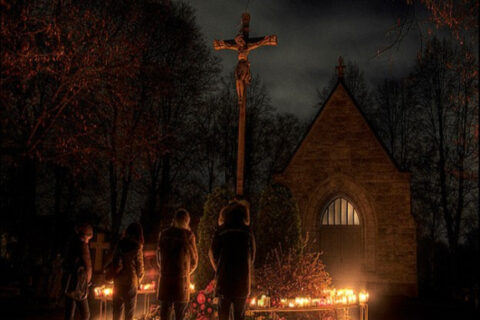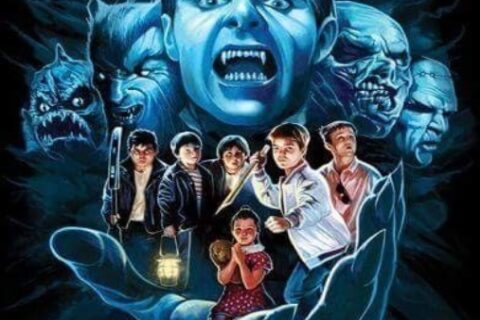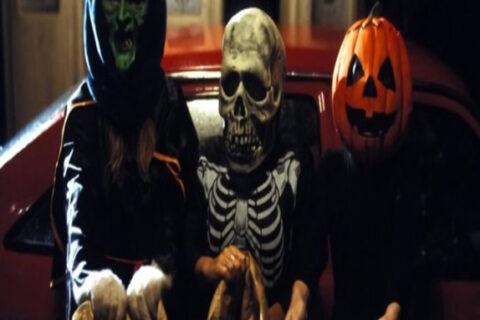The Irish are a superstitious people. They are also a story telling people. Whereas the “Gift of the Gab” is the ability to talk and charm others, there is another side of the oral traditions of Ireland dating back to the Seanachai – the pre-written word custodians of Celtic knowledge, lore, and histories. These stories occasionally get washed-out over time, but for the most part, they are so deeply intertwined with Irish family customs and beliefs, that it is hard to tell the distinctions between fact and fiction. Banshees associated with families… little people underground… devious leprechauns… ghosts… these are the stories around which I grew up. Older family men held the ears of my cousins and me, sitting Indian-style in a circle, captivating our little minds with tales of heroism, bravery, and sometimes terror.
This, however, is the true story of a terrifying find in Ireland.
In Connaught (the West), in County Roscommon, lies an elevated hill (for lack of a better term) that once served as the site of the largest pagan temple in Ireland: Rathcroghan. Upon that hill, a massive temple stood. Within that temple, various seasons would be celebrated with a variety of games, ceremonies, and sacrifices. But beneath that hill was a series of caves – passageways – called “Oweynagat” (the Cave of the Cats).
Oweynagat was sandwiched between the human dimension, upon which the pagan temple stood, and the underworld of all that was both “beautiful” (read “tempting”) and evil, Tír na nÓg (Land of Youthful People). The Ancient Irish pagans did not believe in the afterlife as we conceive of it today. Rather, multiple dimensions existed for both the living and the dead, of which one could be trapped between life and death. This included the Mag Mell (Plain of Pleasures), this earth (ever to wander as ghosts), a return into the natural order (i.e., becoming fertilizer, and emerging as a tree), and yet, others might be reincarnated. The Tír na nÓg was not a place into which one would want to be dragged by its inhabitants – an event that occurred annually during the Celtic pagan New Year, Samhain.
Many who are familiar with Samhain know that it is the origin of the Halloween holiday – a mischievous Irish holiday that was never intended to be a holiday comprised of sugary candies and apple bobbing. Often, there is confusion that Samhain is a celebration of the dead season, but that is really a Catholic interpretation of the holiday, which closely links to All Saints Day (November 1st) and All Souls Day (November 2nd). Rather, Samhain was the end of the harvest, and with it, a new harvest year would emerge, eventually from the ashes (snow) of winter (cold and death). The Ancient Irish who viewed death as merely the beginning of new life, saw the “dead time” – the ending of autumn and the near ascendancy of winter – as the beginning. But with Samhain came an annual event: the escape of demons, ghouls, goblins, and fairies (not the nice ones) from Tír na nÓg for the expressed purpose of dragging or deceiving men and women into their eternal dimension through the Cave of the Cats.
These demonic creatures sought to use their myriad of ways to entice, compel, or force Ancient Celts into their dimension, in an attempt to either feast upon them for eternity, or turn them into that which they already were. For the Ancient Irish, fires were an important means of defending themselves from these evil beasts. Huge bonfires were lit in the center of clan communities, both to scare off the beasts or to ensure any stranger approaching could be seen more closely – and revealed for their true intent. Other beasts ravaged the land to prepare its death for the winter that was coming. Yet, there was a way to stop them – or slow them down.
In an attempt to protect the most important citizens of Ireland at the time, Druids would descend into the Cave of the Cats, with children purchased for the sake of blood sacrifice. Since it was believed that an Ancient Fairy Queen resided amongst the walls of the cave, opening its many passages and portals for demons to escape once a year, the belief was that these demons would be satisfied with the blood of innocents upon which they could feed more easily, instead of going into town. In some cases, the live children were left to the fairies, so as to emerge as fairies themselves – or, in some cases, vicious, vengeful demons. This cyclical pattern was part of a down payment to Hell – continually feeding the beasts potential new recruits in an effort to stave off the present.
Beyond the dimensional wall, within Tír na nÓg, except when her Fairy Queen servant let her escape, was the Morrigan – the Celtic goddess of death, destruction, and passion. Her thirst for child blood was legendary. She especially feasted on young boys and drunken princes. Her appetite was insatiable, many children’s hearts were placed on the grounds of the cave, to feed her need for child flesh.
The blood of babies, children and, on rare occasion, adults, poured through the stone walls and dark encampments of the various passages that stood between earth and the infernal dimension from which the demons emerged. If a child was dressed to look like a particularly well-known beast, it was more likely to be taken back into Tír na nÓg. Meanwhile, the harvest celebration was held just above the heads of screaming and dying children, with feasts and alcohol. While Ancient Celtic warriors and shepherds – most often, one in the same – became drunk on mead, beasts beneath their feet became drunk with the blood of babies.
And why “The Cave of the Cats?” It is believed that cats can see all of these infernal demons. If you see a cat get spooked for no known reason on Samhain, RUN! They see the beasts, but they are too small and nimble to be feasted upon themselves. Unless, of course, it is the Cat Sith. When he emerges toward you, with his black coat and white chest (Tuxedo), he will come to steal your soul with his breath or his eyes. He competes with the beasts that emerge from this Celtic Hell – yet, unlike them, he never has to return. No one knows which tuxedo cat is the Cat Sith – he is a deviant male cat who craves your soul. Regardless, it is rumored that many cats occupied the passages of Oweynagat, and when Ancient Irish citizens saw them scamper out of the cave on the night of Samhain, it was an indication that the demons had emerged from their dimension.
Today, you can visit this mound and its passages. You can walk upon the ground, once littered with the corpses of babies. Rathcroghan looks like a little grassy hill – nothing more. But its lush green grass betrays the fertilizer of choice for that of its demonic origins – child blood.
Happy Halloween.
The son of a recent Irish immigrant and another with roots to Virginia since 1670. I love both my Irish and Southern Nations with a passion. Florida will always be my country. Dissident support here: Padraig Martin is Dixie on the Rocks (buymeacoffee.com)





Always something worthwhile from Padraig Martin. Of course, these quaint ancients weren’t a patch on this age when it comes to making an indemnity of our children. And to judge by the frantic antics of the black cat that moved into the neighborhood last month, we are ridden with demons. I’m not surprised.
Anyway, a fine piece and I will never play ‘The Connaught man’s Rambles’ again in the same frame of mind. May our prayers be heard in All Souls Day.
This some good campfire stuff, right here. Always look forward to reading, thank you.